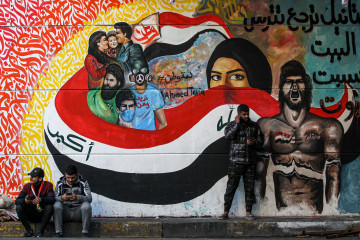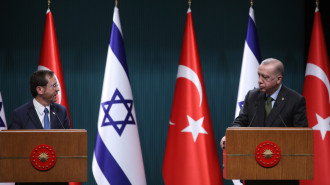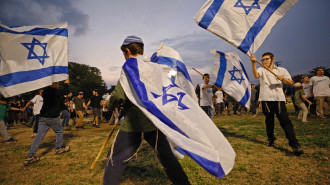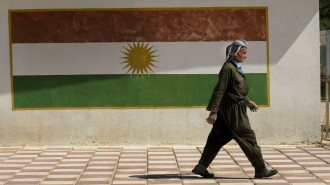

In October 2019, hundreds of thousands of Iraqis took to the streets across the country demanding an end to the ethno-sectarian political system that had been installed after the 2003 US invasion.
They argued that this system had fuelled widespread politically sanctioned corruption and served the interests of political elites rather than those of ordinary people, who suffered from a lack of basic services and widespread unemployment.
In response to the real threat to their authority that the protests posed, Iraq’s political elite have become increasingly repressive. As a result, five years on from the protests, the core grievances of Tishreen remain unresolved and the streets of Iraq have remained eerily quiet this month.
In a context where direct confrontation with the authorities is increasingly proving impossible, activists today have turned to constructive resistance as a means of challenging the status quo in their daily lives and actions.
The co-optation of Tishreen
The Tishreen movement initially enjoyed widespread support and momentum in Iraq and the diaspora, but it soon encountered significant obstacles.
The Iraqi government and affiliated militias initiated a coordinated campaign of repression against protesters, including shooting at them with snipers and aiming expired teargas canisters at their vital organs. This resulted in the killing of 600 protestors and the injury of at least 25,000 others.
Organisationally, the movement also suffered from internal fragmentation. The protesters lacked cohesive leadership and a clear political program, making them susceptible to division and co-option.
While some protesters were enticed into joining mainstream parties and politicians, others decided to form their own independent parties, which quickly fragmented as a result of accusations of corruption and ethno-sectarianism, leading to the movement’s political delegitimisation.
What does the absence of widespread protests mean?
The lack of large-scale protests in Iraq does not mean that the issues that sparked Tishreen have been resolved. Instead, the fear of repression and reprisals is significant among activists.
There is also a palpable sense of exhaustion and trauma. After enduring years of activism with minimal tangible progress, many protesters are physically and mentally depleted.
Compounded by a lack of accountability and persistent impunity within the political elite, this environment stifles dissent, leaving many wary of expressing their views and fearing further suppression.
Iraq’s political elite has also become more adept at stifling dissent through utilising force, propaganda, and co-optation to undermine counter-politics in Iraq.
Universities, which were at the heart of organising during Tishreen, have been staffed with party loyalists to watch students and prevent future mobilisations. Hundreds of thousands of civil service jobs, meanwhile, have been awarded as a means of buying people’s loyalty, and the protests have been painted as a foreign conspiracy against Iraqi interests.
|
|
Could grievances reignite mass protests?
While the current absence of mass protests in Iraq seems to imply that things are on the up, many of the underlying grievances that sparked the Tishreen uprisings persist. The ethno-sectarian political system that Iraqis rejected during the protests has only become more entrenched, and many Iraqis continue to live in precarious economic conditions without access to employment.
Throughout his leadership, Prime Minister Mohamed Shia al-Sudani has made a display of the infrastructural projects that have been completed during his term, and much has been said about the building boom in Baghdad and beyond.
However, many of these projects have been merely cosmetic, intended as a means of boosting the popularity of the political elite ahead of next year’s elections, and to launder the money that they can no longer move abroad due to sanctions. In this context, Iraqis continue to suffer from a lack of basic services, such as clean water and electricity.
Having said this, the relative economic stability that Iraq is currently witnessing, maintained by high oil prices, along with the provision of hundreds of thousands of short-term civil service contracts, continues to appease the public for now.
However, any significant economic or political shocks in the near future - such as deeper involvement in regional conflicts or a drop in oil prices - could erode these short-term solutions and trigger more profound and widespread protests than those seen during Tishreen.
The future of civil unrest in Iraq is thus closely tied to the government’s ability to implement long-term and meaningful reforms to address the systemic issues plaguing the country.
Constructive resistance
Faced with increasing repression and a movement that has largely been co-opted, Iraqi activists no longer have the option of confronting the political elite directly through mass protest. Instead, they have taken on forms of constructive resistance, making subtle but important changes to the status quo in their daily work and lives without endangering themselves or others.
Among the most creative aspects of the Tishreen protests was the street art that activists painted on the walls of the squares they occupied. Today, many of the artists who participated in these activities continue to use art as a means of subtly critiquing Iraq’s political elite and raising awareness of important issues, such as the high levels of environmental pollution that just this month saw Baghdad covered in a toxic cloud of Sulphur Gas.
Others have sought to undertake economic interventions, for example, creating businesses that sell local products to counter what many young people saw during the Tishreen protests as foreign influence on Iraq’s politics and economy.
Tishreen's legacy
The Tishreen protests rocked Iraq’s post-2003 political establishment. It brought Iraqis together against an ethno-sectarian political system that has served the political elite much more than it had ever served them.
In its wake, the political elite has closed rank, increasingly shrinking civic space and making it difficult to confront the authorities through direct forms of resistance. As such, activists have opted to weave resistance into the fabric of daily life and cultural expression.
In this way, they continue to push for change while navigating a complex and often dangerous political landscape in Iraq.
Hayder Al-Shakeri is a research fellow with the Middle East and North Africa programme at Chatham House
Follow him on X: @HayderSH




 Follow the Middle East's top stories in English at The New Arab on Google News
Follow the Middle East's top stories in English at The New Arab on Google News


